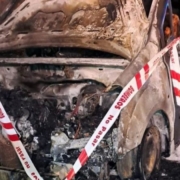Driving with children on Lanzarote? Here’s what you need to know.
Spain’s roads are getting safer all the time, but it’s still a shocking fact that the most common cause of death for children under 14 is a road accident. In 40% of those accidents, no child protection measures were used.
If you’re travelling with children, you’ll want to know that they’re as safe as possible and, fortunately, Spanish law is of the same opinion. Here are rules regarding child safety equipment:
Rear-facing seats
Rear-facing baby seats are compulsory for children aged up to 18 months or weighing less than 13 kilos. The child must be strapped correctly into the seat, which in turn must be safely secured by the seatbelts.
These seats can be used in the front or back seat of the car. However, if in the front seat, the airbag must be deactivated
Front-facing seats
These are for children from 18-months to four years old, and weighing between 9 to 18 kilos.
These seats MUST be located in the back seat of the vehicle, and never in the middle – i.e, they should be behind the driver or passenger seat.
Booster seats
Children from 3 to 12 Years and between 15 – 36 kg must use booster or riser seats which raise the child to a position where the seatbelt fits correctly over the child’s collarbone. Group 2 seats are for younger children and feature supporting back and head rests, while group 3 seats are simply booster cushions which should only be used once the child reaches 22 kilos.
Child seats should meet minimum standards of safety, and this can be checked by looking for the EUapproved sticker – usually an orange sticker on the back of the chair.
Fitting child seats isn’t always as easy or straightforward as you’d expect. Make absolutely sure you’ve got it right, and if you have any doubts at all, ask an expert. If the car you’re using is hired, you’ll usually be provided with adequate child seating but you can still be responsible for not using it correctly.
The Baby On Board sign
An urban legend claims that “Baby On Board” stickers were originally intended for emergency services, advising them to search for children in the case of a serious accident. However this is untrue – the signs were developed in the US in the 1980s to remind other drivers to take care.
They have long fallen out of fashion in the US, but remain popular in the UK, Spain and Lanzarote, where you may even see Canarian variants such as “Chinijo A Bordo”.
For regular updates, pictures and videos of Lanzarote be sure to like and follow our Facebook page “Gazette Life Lanzarote”.











